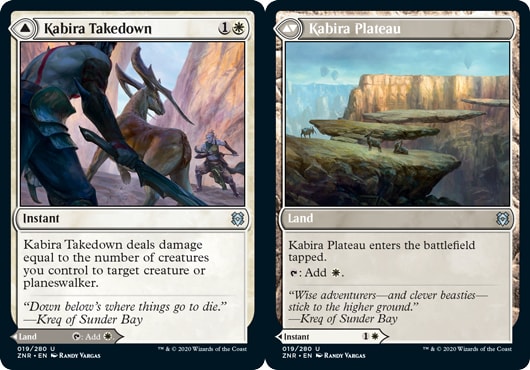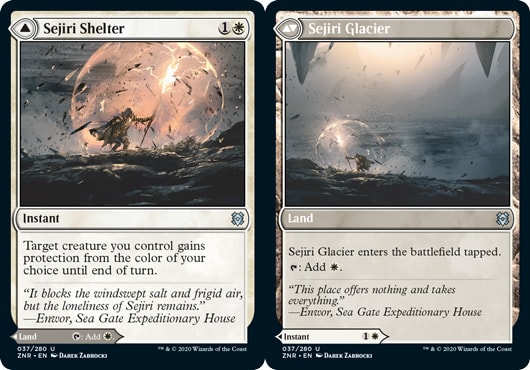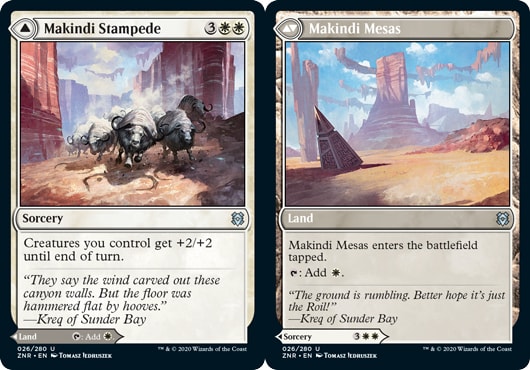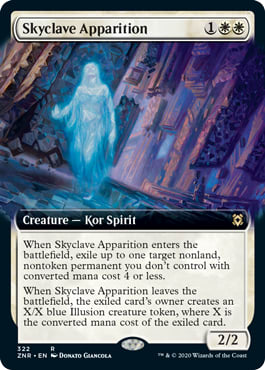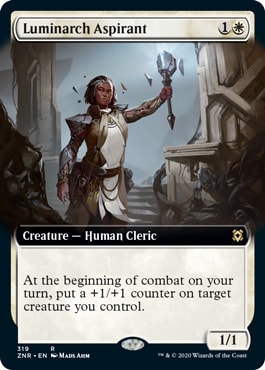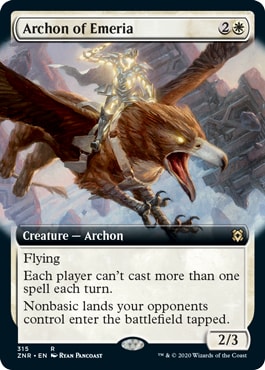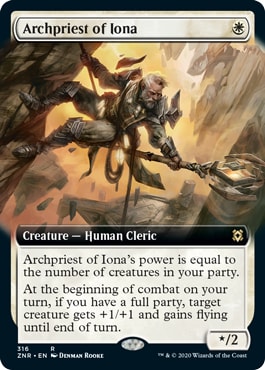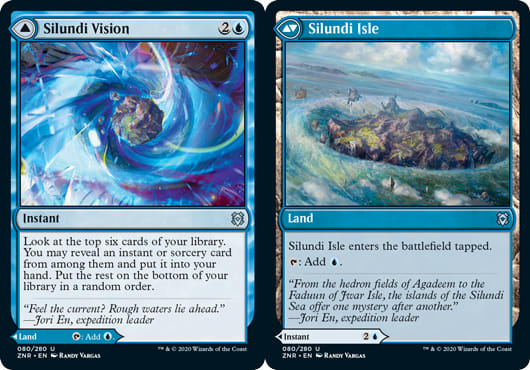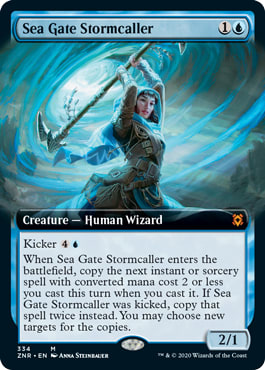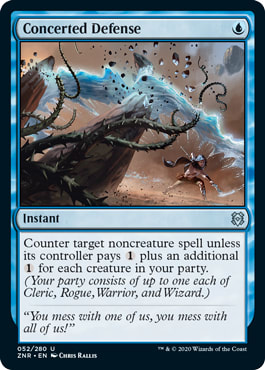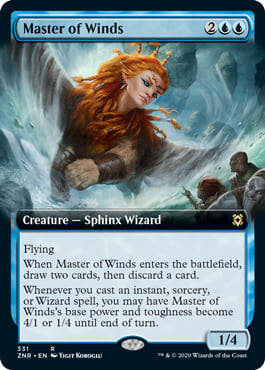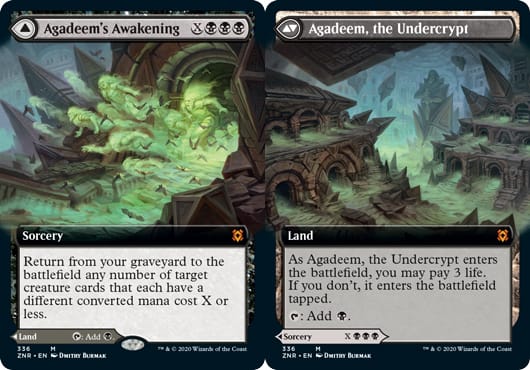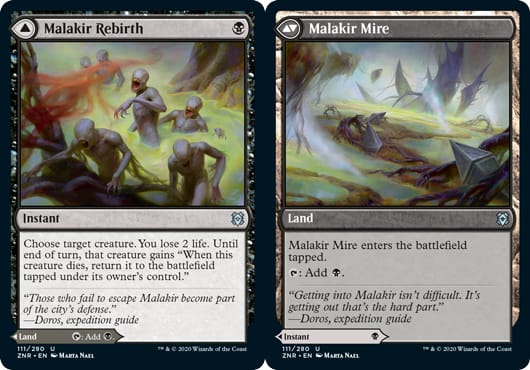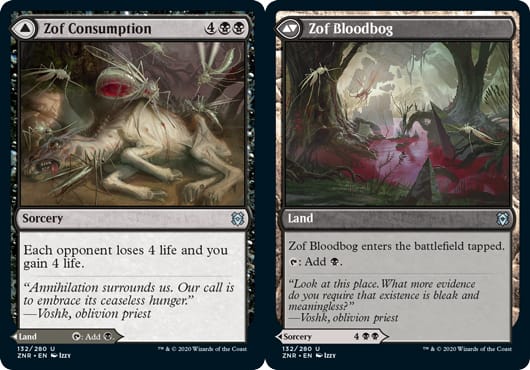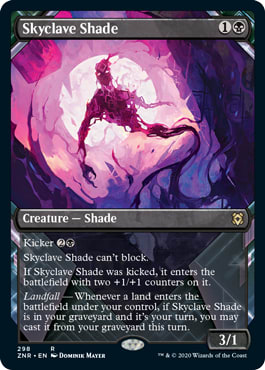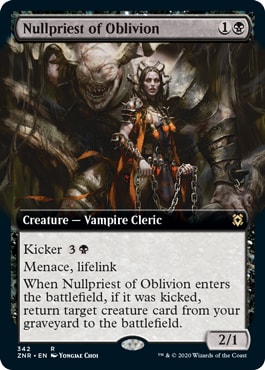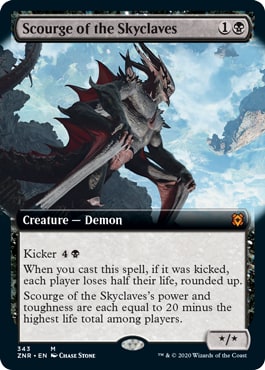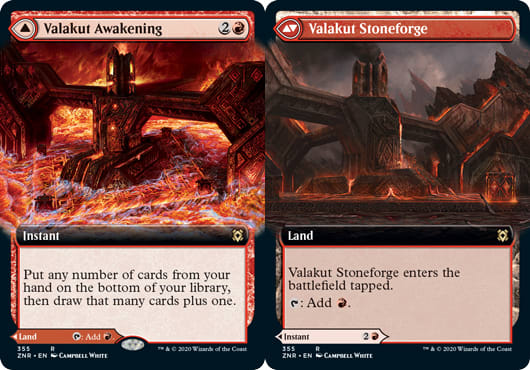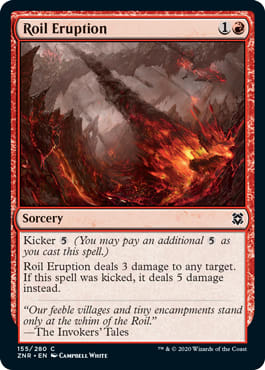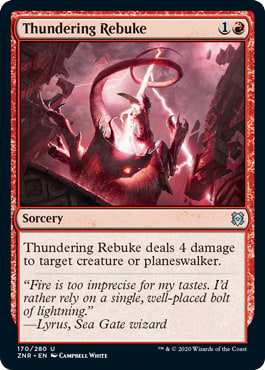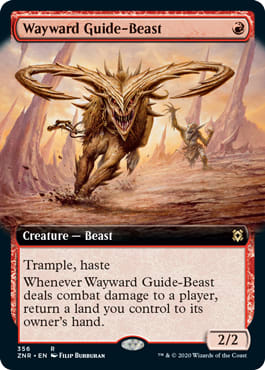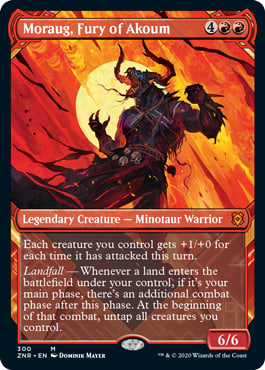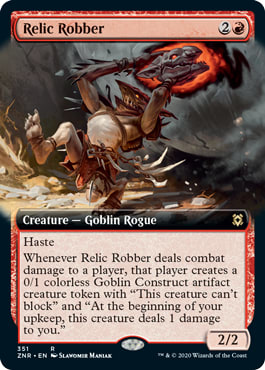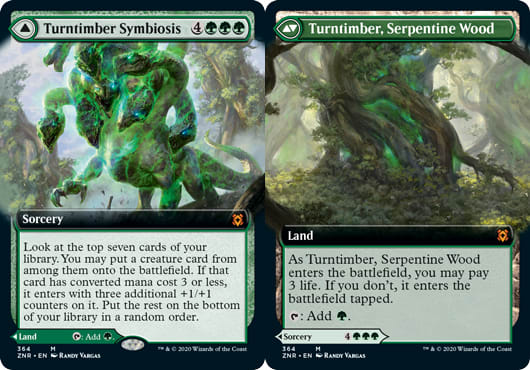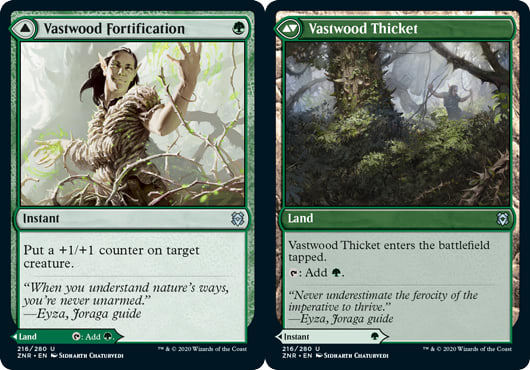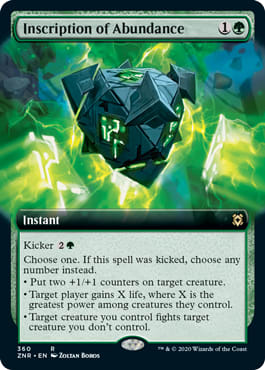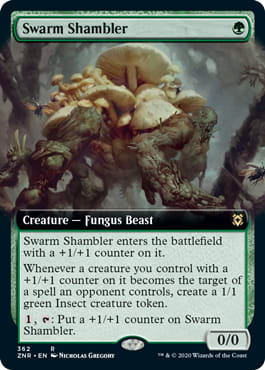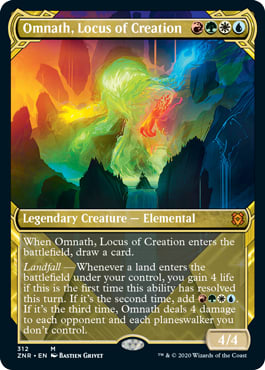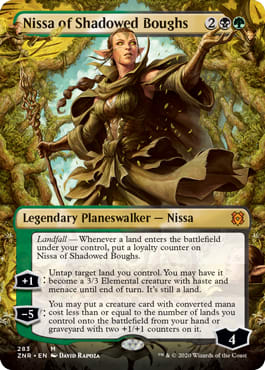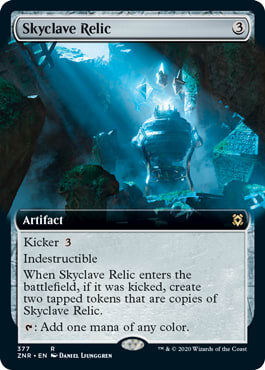Just in time for... Kaldheim, here's an article for Zendikar Rising in Cube!
When I last wrote a Cube article for Ikoria, I talked about how I haven't been able to get much cubing in because of Covid-19. If anything, that's gotten worse as I haven't been able to get as much online Cube drafting going either and I just haven't had the energy to test against myself/my cats (on the left is Merlin, on the right is Chrono, who just keeps picking lands) like I did before I got a regular playgroup.

Because of this, my usual sampling of 3-0 decks to show examples of decks utilizing new cards is going to be paltry even though it's been many months since ZNR released, but the same disclaimer applies - these decks aren't to say that these cards are inherently busted (due to inherent small sample sizes) but merely to illustrate how the card plays out in a deck that did well, and how the card would typically see play. At this point, if you've been following Constructed formats in the past few months, none of this should be surprising. That isn't to say that these are merely cards that have been good in Constructed and therefore are good in Cube, although there's generally a good correlation between the two.
Cards are sorted in order of approximate interest by color - the ones that pique my interest for Cube discussed first in approximate order. I've always tried to make sure my Cube reviews use a pretty "generalist" point-of-view since opinions and builds of Cubes can be vary and trying to write for *all* these points would be nearly useless. You (should) know your Cube's metagame better than anyone else and how your cube's metagame factors will impact how cards play out.
Skip to:
White
Emeria's Call - It's been a while since Zendikar Rising's cards were previewed, but early into ZNR's preview season, Shaheen Soorani had a good quote about evaluations with flexible cards, citing Sea Gate Restoration, and how they tend to be fundamentally wrong (emphasis mine.)
Along with:
Card strength analysis from era comparisons is flawed and worse-case scenario highlights are lazy.
In my Throne of Eldraine Cube review articles, I spent a lot of time talking about how it's hard to evaluate modal cards. There isn't a convenient way to evaluate or quantify flexibility since it's so, well, variant.
Cards with flexible modes have been baked into the game since Alpha's Fireball, Drain Life, and Guardian Angel (amongst others.) It doesn't help that a lot of these kinds of flexible cards are just terrible.
What usually makes these cards work is a general floor of helping a deck achieve its goals. This is where cards like Fireball, Drain Life, and Guardian Angel fail (at least for Fireball in non-rarity restricted Cubes.) While having to Lava Spike yourself to play a land untapped is a high cost, generally I've found that ability has made all five of these mythic Modal Double-Face Cards (MDFCs for short) work out great in Cube decks. The absolute floor of being an tapped land isn't a terrible worst case scenario.
Back in "the before times" and online Cube drafts, I'd see drafters erroneously putting in 7+ mana creatures in their aggro decks, like Elesh Norn, Grand Cenobite and Craterhoof Behemoth. The logic was they would be good topdecks on turns 7+, but that doesn't work out because aggressive decks generally aren't in those late-game scenarios. If they are? Something went very wrong. One could argue that they could be seen as "insurance", but this logic is also incorrect as those expensive threats are dead cards more often than not. When you're looking to kill your opponent ASAP (ie. Your aggro deck's game plan), there are usually better (cheaper) cards left in the Sideboard that would have served that goal better.
That said, aggro decks can find that they're flooding with 7+ lands out, but those game states are the exception, not the rule. What makes cards like Emeria's Call good is that it's primarily an untapped mana source and secondarily flood insurance, whereas high-cost finishers in aggro decks don't have that flexibility. Emeria's Call isn't very efficient as a finisher, but being able to create several high-power evasive creatures allows it to work around game states where aggro is brickwalled (big ground defenders, spot removal.) Mark Rosewater's oft-cited (at least by me) infamous Kavu Titan story gives a valuable lesson on the perils of holding onto a card for too long, and this is important when playing Emeria's Call in aggro decks when controlling 4-5 lands:
During my last match, Randy watched. At some point late in one of the games, I played my Grizzly Bears. After the match was over, Randy informed me that the Grizzly Bears weren't actually Grizzly Bears. They were proxies for Kavu Titan. Armed with this information, the next week I went 2-2. Suffice to say that the R&D guys thought this was the funniest thing ever. The lesson I learned was the importance of using the Kavu Titans as 2/2s. When I was aggressive with Kavu Titan, my deck performed much better. When I waited to maximize the Kavu Titans as 5/5 creatures, I lost much of the aggression of my deck and thus some of its power. Week 3, I went 4-0 again.
Emeria's Call performed best in slower White decks since it allows those decks to include a finisher without having to give up a card slot that would be normally occupied with interaction, card advantage, or something else. Finishers generally tend to be interchangeable in Cube and this is, ostensibly, a big ol' finisher.
For inclusion in a Cube, the main questions that you want to ask yourself are:
- In your Cube metagame, how often are decks able to reach game states where a



 sorcery-speed spell is being cast? (This may be hard to quantify and if you're on the fence on inclusion, utilizing anecdotal information from looking at board states and asking for feedback can help, even if it's a ways from perfect.)
sorcery-speed spell is being cast? (This may be hard to quantify and if you're on the fence on inclusion, utilizing anecdotal information from looking at board states and asking for feedback can help, even if it's a ways from perfect.) - Are you fine with using the slot equity for something else that may be archetype support, a build-around, or something more "exciting?" (if you care about that kind of thing.).
Kabira Takedown, by virtue of entering the battlefield tapped, performs fundamentally differently from the mythic cycle as it can't be relied on as an untapped mana source for curving out. As a result, its spell side has to do a lot more heavy lifting than its untapped brethren.
My initial impression of Kabira Takedown was "This seems... not good in cube." I'm pretty sure I texted those exact words to my podcast cohost, Anthony Avitollo, when I sent him the pictures of Kabira Takedown and Kazuul's Fury to prepare for our preview episode.
I'm unsure if this was because of my initial misread - thinking that Kabira Takedown could only target attacking or blocking creatures a la Outflank - but I wasn't really a fan of it for Cube. But then, I started warming up to the MDFCs as time went on.
The general going rate for a lot of these MDFCs is a one-mana tax on a card for the non-land side; Kabira Takedown is worth somewhere between 1 and 2 mana, since it's better than Outflank, which is about bog standard for a White 1-mana removal effect in sets printed these days. Arguably, Kabira Takedown is a lot closer to ![]()
![]() worth of mana than
worth of mana than ![]() .
.
Cards like Garenbrig Carver, Lonesome Unicorn, and Reaper of Night are examples of both sides of a modal card being too weak to where having access to both halves aren't strong enough to make a good card (at least, in cube,) so there's certainly precedent for these kinds of flexible cards not being a strong package, despite having flexibility. Some of these MDFCs are closer to Reaper of Night than Murderous Rider.
Earlier, I talked about how a lot of what makes a flexible card good in Cube is that the floor is something a Cube wants. Throne of Eldraine's Murderous Rider and Bonecrusher Giant are great examples of this - cards whose respective floors are outclassed by other cards like Hero's Downfall and Shock, but work as an overall package because these cards are so much more than their floors and individual components. Even Shepherd of the Flock, a rather innocuous 3/1 for ![]()
![]() is finally getting the attention it deserves (if anything, for the ability to bounce Showdown of the Skalds) because it does so much more than being a "bad 3/1 for
is finally getting the attention it deserves (if anything, for the ability to bounce Showdown of the Skalds) because it does so much more than being a "bad 3/1 for ![]()
![]() " as MinorBug notes in this article.
" as MinorBug notes in this article.
The 17lands twitter account made some posts about the diminishing returns on winrate with the (tapped) MDFCs, but games have to go very long for that to make a huge difference. Obviously, Cube isn't retail limited, but these tweets highlight that MDFCs aren't just a 1-for-1 swap for basic lands.
A lot of what makes the good MDFC cards good is how well they help decks mitigate mana flood, giving them late-game functionality even if it's at a bad rate. The post-errata Ikoria companions are a good example of this. Something like Jegantha, the Wellspring is relatively unimpressive as an eight mana 5/5 with some flavor text, but having the ability to fetch Jegantha, the Wellspring when you have the mana lying around makes it more valuable. The MDFC cards don't necessarily have inherent deck-building constraints like the Companions do, but they do come with a cost of inclusion by possibly tripping you up when curving out.
Kabira Takedown skirts this line by being removal if need be, especially as a lot of these kinds of effects (ie. 2nd rate White removal) tend to be bad in aggro decks. They're not great at clearing out blockers, either by giving them one (Afterlife/Crib Swap) or just not interacting with them until combat (Outflank).
That being said, the costs that come with a land entering tapped are quite real, and as cliche as it may sound, where you draw the line ultimately lies with the power level of your Cube. After all, flexibility may not mean much if you're unable to enact your gameplan in time, which is a factor that tends to get overlooked when talking about lands in Cube and how inherently powerful entering the battlefield untapped is.
With Kabira Takedown, in addition to the slot equity question, something you will want to ask yourself is how *often* aggro decks are fully curving out - having a critical mass of 1-drops certainly can help aggro decks "take a mana off", if need be, but as the inherent power level of a Cube goes up, as SirFunchalot puts it, so too does the pressure *for* those decks to be able to enact their gameplan ASAP, even moreso than usual.
However, here's an example of a midrange deck that isn't interested in beating down on turn one but is able to utilize Kabira Takedown as a mana source. An atypical example, but an interesting one:
Cube Example #1 | Cube | Usman Jamil
- Creatures (11)
- 1 Bloodbraid Elf
- 1 Bronzehide Lion
- 1 Burning-Tree Emissary
- 1 Fleecemane Lion
- 1 Gruul Spellbreaker
- 1 Mother of Runes
- 1 Phoenix of Ash
- 1 Scavenging Ooze
- 1 Tireless Tracker
- 1 Rhonas the Indomitable
- 1 Thrun, the Last Troll
- Planeswalkers (2)
- 1 Chandra, Torch of Defiance
- 1 Garruk Relentless
- Instants (4)
- 1 Kabira Takedown
- 1 Lightning Helix
- 1 Lightning Strike
- 1 Searing Spear
- Sorceries (5)
- 1 Fiery Justice
- 1 Firebolt
- 1 Flame Slash
- 1 Sevinne's Reclamation
- 1 Winds of Abandon
- Enchantments (3)
- 1 Prison Realm
- 1 Seal of Fire
- 1 Sylvan Library
- Artifacts (1)
- 1 Sanctuary Blade
Sejiri Shelter and Skyclave Cleric skirt this line similarly, since they're cheap enough to be able to be cast reliably, if need be. Skyclave Cleric has some merit as a strange 1/3 for aggro (as a tool for the mirror) or control as a roadblock, but I haven't seen it. Sejiri Shelter's 1-mana tax makes it much harder to use as a combat trick/way to protect against removal, but if the power level of your Cube allows for that kind of split card, it's certainly an option to pursue.
Due to the inherent costs of entering the battlefield tapped, the spell sides of Ondu Inversion and Makindi Stampede are much closer to Garenbrig Carver than Murderous Rider, because of the inefficiency of their spell sides.
Skyclave Apparition - when I asked for decklists featuring Zendikar Rising, this and Luminarch Aspirant were the big standouts, since they help White decks so much (moreso aggressive flavors of White.)
Someone described Skyclave Apparition as the best White creature of all time, and while I'm not sure if it's that good, it's certainly very good.
Like just about every Banisher Priest variant, it dying mid-combat can lead to some bad blowouts in aggressive decks, but I found things never played out as people feared. Usually, the illusion, in terms of raw stats, was almost always worse than whatever was exiled but it did still make for a roadblock for aggro hordes.
Cards like Banisher Priest suffered because their timing windows were pretty narrow - generally just hitting a ham sandwich to clear out when curving out and attacking or alpha striking. Unfortunately, Banisher Priest and its ilk were terrible against Mulldrifter-style creatures that have already gained value once they hit the field. There aren't a lot of small Mulldrifters out there, needing to use a Banisher Priest against a Wall of Omens/Wall of Blossoms was usually a terrible thing to do, moreso if the priest then left the battlefield. Banisher Priests also suffered due to their bad states if they had nothing to exile, which was generally a problem when trying to kill an opponent bolstering for the long game.
Skyclave Apparition has also been solid in non-aggro decks as an Oblivion Ring type card to hit problematic permanents. Overall, I've been a big fan.
Luminarch Aspirant - unlike Skyclave Apparition, this has been played solely in White aggro decks. It has earned the nickname of The White Tarmogoyf and honestly it's not that much of an exaggeration in terms of how well it punches above its weight class. I've found its ability to spread the wealth is excellent as well, especially for evasive creatures or breaking apart board state stalemates. While White 1-drops are the backbone of Cube aggro decks, this has been great to supplement White aggro decks, like this list from fleish_dawg's Synergon cube!
Cube Example #2 | Cube | Synergon
- Creatures (20)
- 1 Charming Prince
- 1 Dauntless Bodyguard
- 1 Knight of the Reliquary
- 1 Metallic Mimic
- 1 Monastery Swiftspear
- 1 Noble Hierarch
- 1 Seasoned Hallowblade
- 1 Skyclave Apparition
- 1 Tajic, Legion's Edge
- 1 Thraben Inspector
- 2 Champion of the Parish
- 2 Luminarch Aspirant
- 2 Mikaeus, the Lunarch
- 2 Thalia's Lieutenant
- 2 Venerable Knight
- Instants (6)
- 1 Dromoka's Command
- 1 Lightning Helix
- 1 Lightning Strike
- 2 Blossoming Defense
- 1 Bonesplitter
- Lands (14)
- 2 Plains
- 1 Arid Mesa
- 2 Sacred Foundry
- 2 Stomping Ground
- 2 Windswept Heath
- 2 Wooded Foothills
- 3 Temple Garden
Yet another solid White aggro card. With these two and Maul of the Skyclaves, White aggro got a lot of great new tools.
Maul of the Skyclaves has played as a much better version of Griffin Guide by providing first strike and being able to be utilized without the potential for being blown out by instant-speed removal. Re-equipping it onto another creature takes a lot of mana and can be used to allow an attacker through, and to reequip a chump blocker for defense, although this type of scenario has been rare. As noted, White non-creature buffs tend to be not seen as often in Cube because those precious non-creature non-land slots in aggro decks are so limited. The old guard of the Darksteel/Mirrodin/Masters Sword of X and Y have long been stalwarts in Cube but I've liked this to supplement (not replace) them because of the immediacy of impact.
Archon of Emeria - We've seen our fair share of 3-mana hatebears and, arguably, Skyclave Apparition is another in that line of disruptive beater. Archon is very outclassed by the Ghost with the Most and this is mostly another in the line of hosers for players who like to be greedy with their non-basic land counts/to shore up multicolored midrange matchups and storm (if that's applicable in your Cube). While this may come down a bit late in a storm matchup, it's able to at least provide some disruption in a pinch.
Archpriest of Iona - In the War of the Spark Cube Review, I made the following note, and it looks like these past few years have been following that same trend:
I recall Andrew was essentially saying how he was unhappy with Standard aggro decks having a ton of 1-drops and that Play Design listened to his feedback and toned down the 1-drops for aggro decks. Aside from Throne of Eldraine's Venerable Knight and Kaldheim's Usher of the Fallen, we just haven't seen many 2/1s for 1 to bolster aggro decks.
Party payoffs are hard to get going in Cube, although, that is somewhat alleviated by the existence of previous set subthemes like Fate Reforged's Warriors (Mardu Woe-Reaper, Secure the Wastes). Unlike cards like Heirloom Blade, it's hard for this to incidentally be good on its own without really working for it, and usually those kinds of micro-payoffs for a single/few cards aren't worth pursuing in Cube, especially in aggro decks. While I always preach inclusion of more early drops to make aggro decks tick, there are better options than this.
Felidar Retreat - This has some resilience vs removal but is slow to get going. There's the old joke that Gideon, Ally of Zendikar was a planeswalker with one mode, and this feels a little like that. Although I talked about how flexibility makes a card play better than the sum of its parts, Felidar Retreat generally played out like a weak planeswalker. It did play better if there were multiple fetchlands or pieces of land ramp in a deck, though.
Angel of Destiny - On pure power-level, it falls short. It has no removal resistance, and it's not very good at killing an opponent without extra help. Inclusion mainly depends on the goals of your Cube, and if you feel that a White lifegain-supporting card is worth it.
Blue
Sea Gate Restoration - Despite citing Shaheen Soorani's quote about how this card is absurd, this is definitely the worst of the mythic cycle for Cube since the payoff for using it doesn't align that well with a lot of reactive Blue decks. Tapping ![]()
![]()
![]()
![]() on the main phase doesn't really jive with the usual Blue Cube plan of doing things at instant speed and holding up mana while requiring several cards in hand to really feel like you got your mana's worth out of it.
on the main phase doesn't really jive with the usual Blue Cube plan of doing things at instant speed and holding up mana while requiring several cards in hand to really feel like you got your mana's worth out of it.
The same questions with Emeria's Call apply to this as well. It's worse overall as a card, but in the grand scheme of things, plays similarly a similar role as flood insurance.
Jwari Disruption - The obvious comparison is between this and Censor, as they're both ![]()
![]() counterspells that Force Spike a spell. From Cultic Cube's video citing data from when his cube was on MTGO, he talked about how Censor was one of the better counterspells out there, and even though Jwari Disruption is certainly worse, being worse than one of the best isn't a death sentence.
counterspells that Force Spike a spell. From Cultic Cube's video citing data from when his cube was on MTGO, he talked about how Censor was one of the better counterspells out there, and even though Jwari Disruption is certainly worse, being worse than one of the best isn't a death sentence.
Earlier, I talked about how, for archetypes like White aggro, a land entering the battlefield tapped can mean the difference between a win and a loss. This applies to control as well, but those decks often find themselves with expendable lands.
Oddly, this isn't that great on turn eight, unlike cards like Mana Leak which find themselves relevant at just about all stages of the game. Because of that, it straddles this weird line where it's mostly just relevant in the mid-game, and you'd counter a ham sandwich to get value out of it, or it stymies aggro players. The latter is where it seems to work out best - against decks that want to curve out on a lean curve.
Silundi Vision - Generally, these kinds of cards see more Constructed play than Cube play, because it's easier to make the conditions work (like Lead the Stampede in a nearly all-creature Elf tribal deck) - conditions that are much harder to replicate in a Cube environment. The fact Silundi Vision hasn't taken off in Constructed isn't a good look in the first place.
That said, looking at this deck:
Cube Example #3 | Cube | Usman Jamil
- Creatures (3)
- 1 Innocuous Insect
- 1 Snapcaster Mage
- 1 Vendilion Clique
- Planeswalkers (4)
- 1 Gideon, Ally of Zendikar
- 1 Jace, the Mind Sculptor
- 1 Oko, Thief of Crowns
- 1 Teferi, Hero of Dominaria
- Instants (9)
- 1 Censor
- 1 Condescend
- 1 Counterspell
- 1 Fatal Push
- 1 Heartless Act
- 1 Path to Exile
- 1 Swords to Plowshares
- 1 Ulcerate
- 1 Vendetta
- Sorceries (5)
- 1 Day of Judgment
- 1 Lingering Souls
- 1 Serum Visions
- 1 Toxic Deluge
- 1 Vindicate
- Enchantments (3)
- 1 Shark Typhoon
- 1 Silkwrap
- 1 Sylvan Library
With 12 hits, Silundi Vision would have about a 60% hit rate. If we increase the hit count to 18, it'd be about an 85% hit rate. This is, of course, a failcase on a card that is meant to be flood insurance, so it isn't the absolute worst. It's at least a chance on something, as opposed to a land, which would have done almost nothing.
Admittedly, I have a lot more tolerance for this kind of effect, but whiffing on this can just be the absolute worst feeling. Temper expectations based on your (and your expected group's) tolerance for RNG and the impact on game win/loss whiffing on this would be.
Glasspool Mimic - I'd have been a much bigger fan of this in any other color, since other colors are able to leverage the ability to clone one's own creatures better than Blue (by virtue of generally having less creatures than other color decks). Still, it's not too bad as a way to explicitly support more creature-heavy Blue decks.
Beyeen Veil can work as a trick to help shore up matchups against aggro, but due to the inherent limitations of Fog effects - narrow timing windows of usefulness even against aggro and nearly useless otherwise - this is a ways from making many Cubes aside from as a matchup tool. Similarly, Umara Wizard suffers by being poor on rate, but it's an option for decks that want to have a finisher without giving up slot equity in a deck. Still, your Blue decks can likely do better.
Sea Gate Stormcaller's kicker mode is usually game over, but I found it almost never happened. Holding a spell while waiting for ![]()
![]() +
+ ![]()
![]() + spell mana was usually just worse than casting the spell by itself. Requiring a card in hand is also significantly worse than Snapcaster Mage, but honestly, Snapcaster Mage isn't what you should be comparing this to. Look to something like Dualcaster Mage instead, a way to make instants and sorceries in hand better. Usually, I found that trying to kick this was a pipe dream and resulted in the kind of Kavu Titan style losses referenced earlier. Meanwhile, running it out on turn three or four with a cantrip was a good play.
+ spell mana was usually just worse than casting the spell by itself. Requiring a card in hand is also significantly worse than Snapcaster Mage, but honestly, Snapcaster Mage isn't what you should be comparing this to. Look to something like Dualcaster Mage instead, a way to make instants and sorceries in hand better. Usually, I found that trying to kick this was a pipe dream and resulted in the kind of Kavu Titan style losses referenced earlier. Meanwhile, running it out on turn three or four with a cantrip was a good play.
Over the years, I've seen cards get underrated because of inevitable comparisons to others, especially since this is another ![]()
![]() 2/1 wizard, which brings Snapcaster Mage to mind. Once you realize that this isn't a Snapcaster riff, your evaluations will be closer to how I've seen it play out in Cube.
2/1 wizard, which brings Snapcaster Mage to mind. Once you realize that this isn't a Snapcaster riff, your evaluations will be closer to how I've seen it play out in Cube.
Jace, Mirror Mage is usually played as a 5-drop to draw through lands for pure card advantage. The trope that it can't protect itself is true and is why I haven't been impressed with it as much as I wanted to be. It's more of a role filler, a la Jace Beleren, to draw cards and do nothing more. That's fine, but can be done better with cantrips. Despite its high "ranking" here, it's your usual mid-level planeswalker - overrated because of its card type but overall a fine method of drawing cards if you're looking for 3+ mana card advantage tool.
Thieving Skydiver - It doesn't take a rocket scientist to say this is good against low-cost mana rocks, and its stock increases with an increased artifact count in the Cube. Because of this, inclusion in a maindeck vs sideboard mainly depends on your Cube's metagame with regards to how many artifacts are in the average deck and how often "attacking" Blue decks come together. This isn't great in a generic Blue Cube deck unless it's able to consistently nab something, but that isn't as important in a deck that actually wants a 2/1 flier for two mana.
Concerted Defense - This isn't too bad as an odd Spell Pierce-style card, but it's usually closer to its one-mana-taxing floor rather than the upside promises.
Master of Winds - In a world of many tap-out value plays for four mana, this is yet another one. Honestly, you can likely do better, but the option to dump something into the grave may be worth the slot for graveyard shenanigans. Even then, there're better ways to serve the role of tap out threat and graveyard dump.
Insciption of Insight - Cryptic Command at Home isn't a great card for a lot of Cube decks, especially being a sorcery-speed four-drop. There's some merit to consider it as a Maro-style creature with some flexibility, but the card doesn't do much that most Blue decks want to do.
Black
Agadeem's Awakening is mainly for Black aggro as a mana source that incidentally gets back a few things from the graveyard (usually just a 1-drop and 2-drop are enough). I've found that having the flexibility of casting this on the cheaper side makes it a great Cube card, like Shatterskull Smashing. There's a joke in my group of buddies that I splash so much in greedy decks that I'd play this on the splash, but I'm pretty sure I'll actually do it one of these days.

Its value drops if not supporting aggro, since it then mimics cases where you're spending ![]()
![]()
![]()
![]() to reanimate a 4-drop. This puts it in the realm of judging its playability based on that as a worst-case, not reanimating a couple of cheap creatures, and ultimately, you know where this line lies.
to reanimate a 4-drop. This puts it in the realm of judging its playability based on that as a worst-case, not reanimating a couple of cheap creatures, and ultimately, you know where this line lies.
Malakir Rebirth is quite the combat trick that makes trades work really well in your favor and acts somewhat like a Shelter type variant to protect your own threats. Similar to Sejiri Shelter, it's cheap enough to hold mana back for if need be, and helps aggro decks shore up against removal-heavy decks.
Hagra Mauling - I never really saw it cast for ![]()
![]()
![]() but this is still fine as a
but this is still fine as a ![]()
![]()
![]() Murder. Usually, I refer to bad
Murder. Usually, I refer to bad ![]()
![]()
![]() removal spells like Sever Soul, Weed Strangle, and Lich's Caress as the hallmark of a Limited format - removal that is clunky and overcosted. Although this certainly isn't mana efficient, it's closer to a Doom Blade than Sever Soul in power level due to it providing some flood insurance in most Cube matchups and a land in matchups where there are few creatures.
removal spells like Sever Soul, Weed Strangle, and Lich's Caress as the hallmark of a Limited format - removal that is clunky and overcosted. Although this certainly isn't mana efficient, it's closer to a Doom Blade than Sever Soul in power level due to it providing some flood insurance in most Cube matchups and a land in matchups where there are few creatures.
Blackbloom Rogue isn't too bad as a Blind Phantasm with menace that can hold the fort and then swing to finish out the game. Because of this, it usually played more as a roadblock than a supplemental threat. Still, not bad.
Zof Consumption - Easily the worst of the MDFCs in Black. It plays somewhat like Fireblast where it has just one job - to finish off an opponent who's low on life, but is just much worse at it. The timing windows line up poorly, requiring six mana, only usable when the opponent is near death, and is potentially game-losing by virtue of being a tapped land when an untapped one is needed. These things mean it's just not very well suited for Cube.
Bloodchief's Thirst is the best non-MDFC in Black and arguably the best Black card in the set, since it's cheap removal when it matters but can scale up if need be as a Hero's Downfall type card.
Cube Example #4 | Cube | Usman Jamil
- Creatures (6)
- 1 Jace, Vryn's Prodigy
- 1 Kess, Dissident Mage
- 1 Rekindling Phoenix
- 1 Sea Gate Stormcaller
- 1 Snapcaster Mage
- 1 Wall of Omens
- Planeswalkers (4)
- 1 Chandra, Torch of Defiance
- 1 Daretti, Ingenious Iconoclast
- 1 Jace, Memory Adept
- 1 Nicol Bolas, Dragon-God
- Instants (10)
- 1 Bedevil
- 1 Burst Lightning
- 1 Cling to Dust
- 1 Drown in the Loch
- 1 Electrolyze
- 1 Fatal Push
- 1 Ghastly Demise
- 1 Kaya's Guile
- 1 Kolaghan's Command
- 1 Lightning Helix
- Sorceries (2)
- 1 Bloodchief's Thirst
- 1 Flame Slash
- Enchantments (1)
- 1 Bitterblossom
- Artifacts (1)
- 1 Sensei's Divining Top
Skyclave Shade isn't Bloodghast but works somewhat similarly as a Black aggro 2-drop that just doesn't die and gets better if drawn late. I've found it to be excellent even without explicit sacrifice synergies as a 3/1 with amazing resilience. It's something that can be brought in against removal-heavy control decks as a pure damage source to pressure planewalkers in a deck like midrange, but as a pure aggro beater, it's stellar.
Nighthawk Scavenger - Vampire Nighthawk is the obvious analog, and with a deathtouch creature, the difference between 1 and 2 power isn't as bad as it may seem. Whenever I saw it cast, it didn't stay as a 1-power creature for long since it just incidentally grows by playing Magic. It's been a while since Vampire Nighthawk was considered a "Cube staple" and it's arguable that adding a bunch of power isn't going to do all that much to help its staying power in 2021, but it's still fine as a tap-out threat for three mana, depending on the matchup. In racing scenarios, it can solo a race.
Nullpriest of Oblivion - Kicker isn't as much of a thing as you'd think, and generally it's more of an "honest" reanimation - ie. bringing back a 3-drop, and not a giant creature, because its base stats point to it being best as a small evasive beater in aggro. Its kicker, as one can expect, made it mainly a late game play rather than being a tool for midrange to play the world's worst Zombify, so adjust expectations accordingly.
Scourge of the Skyclaves - In many Cubes, it's very difficult to make Death's Shadow work since it requires having many ways to deal damage to yourself in. In a Cube deck with no other payoffs for doing so, it is almost always a bad idea. Scourge of the Skyclaves can supplement Death's Shadow but I've found it to be much better as a playable Black aggro threat in decks that just so happen to have a few sources of self-damage. It can be absurdly large in the mirror and I found, even outside of the aggro mirror, it was regularly at least a 3/3. A 3-power beater is about the base rate of what you would want out of a 2-drop aggro creature.
Decks like this serve as a good example of not going out of your way to make it work:
Cube Example #5 | Cube | Usman Jamil
- Creatures (10)
- 1 Dark Confidant
- 1 Deathrite Shaman
- 1 Kroxa, Titan of Death's Hunger
- 1 Murderous Rider
- 1 Phoenix of Ash
- 1 Scourge of the Skyclaves
- 2 Bonecrusher Giant
- 2 Magmatic Channeler
- Planeswalkers (1)
- 1 Liliana, the Last Hope
- Instants (6)
- 1 Eliminate
- 1 Fatal Push
- 1 Kolaghan's Command
- 1 Lightning Bolt
- 2 Incinerate
- Sorceries (8)
- 1 Bloodchief's Thirst
- 1 Flame Slash
- 1 Shatterskull Smashing
- 1 Strafe
- 2 Thundering Rebuke
- 2 Unearth
- Lands (14)
- 2 Mountain
- 4 Swamp
- 1 Arid Mesa
- 1 Blood Crypt
- 1 Silent Clearing
- 1 Sunbaked Canyon
- 2 Barbarian Ring
- 2 Scalding Tarn
Soul Shatter gets around the worst part of Edicts, being negated by small creatures, and it almost always hits the best targets on the board. Thus, it generally plays out like a Hero's Downfall type of creature removal that incidentally can hit planeswalkers and therefore is "live" often; it's a little expensive for a spot removal effect, but I found the ability to hit planeswalkers makes it worth it.
Acquisitions Expert - As noted earlier with Archpriest of Iona, it's hard to get tribal payoffs going, but Dimir decks may be able to get a party of two because of wizards in Blue. As a marginally better Ravenous Rats variant, there are better options for 2-drops, unless the discard on a body is something that your Cube values.
Red
Shatterskull Smashing - When one mode of a card looks terrible, it's easy to fall into the trap of deducing that the rest of the card is bad. I saw a lot of that kind of evaluation with Shatterskull Smashing, where it was deemed to be something like a "bad Forked Bolt at four mana" that failed to take into consideration how it actually plays in Red decks.
What this card excels at is being able to clear blockers out of the way while being an untapped mana source if need be. Even if it's a "bad Forked Bolt" at four mana, in those scenarios, a land would have been completely useless, and including it in a deck doesn't prevent curving out either. It may not clear blockers out at an efficient rate (although it does in aggro mirrors), but I found that it was usually good enough at getting rid of blockers or, potentially, a planeswalker. That said, here is an example of Shatterskull Smashing in a non-aggro 3-0 deck:
Cube Example #6 | Cube | Usman Jamil
- Creatures (10)
- 1 Abbot of Keral Keep
- 1 Blade Splicer
- 1 Charming Prince
- 1 Dire Fleet Daredevil
- 1 Giver of Runes
- 1 Luminarch Aspirant
- 1 Magmatic Channeler
- 1 Monastery Mentor
- 1 Palace Jailer
- 1 Skyclave Apparition
- Planeswalkers (2)
- 1 Gideon, Ally of Zendikar
- 1 Serra the Benevolent
- Instants (8)
- 1 Abrade
- 1 Burst Lightning
- 1 Lightning Bolt
- 1 Lightning Helix
- 1 Lightning Strike
- 1 Mana Tithe
- 1 Searing Spear
- 1 Swords to Plowshares
- Sorceries (4)
- 1 Chain Lightning
- 1 Council's Judgment
- 1 Roil Eruption
- 1 Shatterskull Smashing
- Artifacts (1)
- 1 Heirloom Blade
Valakut Awakening is, like Wildfire, a card that isn't good in aggro decks but plays well in slower Red decks by being able to get a use out of situational or bad cards. It's one of the best cards at mitigating mana flood since it can draw into business at the end of turn by replacing itself if a wheel effect isn't needed. It's either a mountain that enters the battlefield tapped or being a card that effectively has cycling 3. Much like Glasspool Mimic, it's in the worst color for it, but conceptually, it's a solid card.
Spikefield Hazard - Aggro decks get every ounce of value out of their cards. Spikefield Hazard is arguably ok on rate but isn't necessarily worth a card. Although it aligns with the Red aggro gameplan of being a damage source, Aggro is the archetype that gets hurt most by this entering the battlefield tapped. It's not too bad as a way to "go big" in an aggro mirror by being something to pick off 2/1s + 1/1s from the Green decks and being a mana source if you're siding into bigger threats.
Cube Example #7 | Cube | Usman Jamil
- Creatures (12)
- 1 Birds of Paradise
- 1 Bloodbraid Elf
- 1 Courser of Kruphix
- 1 Elvish Mystic
- 1 Gilded Goose
- 1 Jadelight Ranger
- 1 Klothys, God of Destiny
- 1 Merfolk Branchwalker
- 1 Noble Hierarch
- 1 Phoenix of Ash
- 1 Thrun, the Last Troll
- 1 Troll Ascetic
- Planeswalkers (2)
- 1 Chandra, Torch of Defiance
- 1 Wrenn and Six
- Instants (4)
- 1 Burst Lightning
- 1 Khalni Ambush
- 1 Kolaghan's Command
- 1 Spikefield Hazard
- Sorceries (6)
- 1 Angrath's Rampage
- 1 Assault // Battery
- 1 Bala Ged Recovery
- 1 Dreadbore
- 1 Green Sun's Zenith
- 1 Roil Eruption
- Enchantments (1)
- 1 Sylvan Library
Kazuul's Fury, Akoum Warrior, and Song-Mad Treachery suffer by being extremely expensive for their role. Arguably, the CMC change doesn't matter a lot with Song-Mad Treachery, since it usually just ends the game when cast, but its high cost relegates it to a game-finishing card that is terrible otherwise.
Magmatic Channeler is one of the best looters of all time, and I've found that in Red, burn-heavy aggro decks, it gets big pretty quick. Even slower Red decks have been able to utilize it as a looter-style card to get rid of jank and to attack as a 4/4 in the later stages of the game. Its weak Maritime Guard stats make it not the best attacker and thus it tends to be on the lower-tier of aggro-only Red 2-drops, but it's been able to straddle the line between Red archetypes in Cube.
Like in this deck from fleish_dawg's Synergon Cube!
Cube Example #8 | Cube | Synergon
- Creatures (12)
- 1 Brazen Borrower
- 1 Cloudkin Seer
- 1 Snapcaster Mage
- 1 Stormwing Entity
- 1 Thraben Inspector
- 1 Wall of Omens
- 2 Enigma Drake
- 2 Magmatic Channeler
- 2 Skyclave Apparition
- Planeswalkers (1)
- 1 Chandra, Torch of Defiance
- Instants (9)
- 1 Burst Lightning
- 1 Lightning Helix
- 1 Mental Note
- 1 Opt
- 1 Start // Fire
- 1 Vapor Snag
- 1 Wild Slash
- 2 Lightning Bolt
- Sorceries (2)
- 1 Flame Slash
- 1 Sevinne's Reclamation
- Lands (16)
- 2 Island
- 2 Plains
- 5 Mountain
- 1 Arid Mesa
- 1 Flooded Strand
- 1 Steam Vents
- 4 Hallowed Fountain
He described it as a card that played similarly to a Level Up creature like Student of Warfare, but one that didn't tie your mana down on your main phase, and that made its power even more apparent. Like Valakut Awakening, it may be better in another color but this works well enough with Red's goals to be a good card.
Akoum Hellhound works well within the Philosophy of Fire as more of a somewhat bursty damage source that attacks for two in the early stages of the game and then chump blocks or carries some equipment later. Although it may look extremely similar to its originator - Steppe Lynx - Red's game plan of utilizing burn works slightly better with how Akoum Hellhound plays out (deals a few damage early, and if it's useless in the later game, it did its job). For the most part, this is another 1-drop to consider for critical mass aggro decks to curve out.
Fireblade Charger is a filler 1/1 that has mostly acted like a Goblin Arsonist with some upsides that aren't relevant that often. Like with Archpriest of Iona, run only if the well is completely dry on 1-drops with two power.
Roil Eruption is a straight-forward burn spell. It almost never gets kicked, but plays about as well as one would expect; this ain't rocket surgery.
Thundering Rebuke plays like a little sorcery speed Hero's Downfall. It can kill most things, or at least put a large dent into a planeswalker. It's been surprisingly good, and made the maindeck of a lot of the 3-0s in this article as the PW damage rules change really showed how weak "creature only" Red damage spells were. Rebuke is part of a shift to Red removal spells that can also kill walkers, while enjoying the high damage rate that creature-only damage spells deal.
Kargan Intimidator is fine as a filler 2-drop with some late game potential to get singular chump blockers out of the way and to push through damage. While it lacks immediate impact, I've liked it as a way to push some damage through to enact the Red aggro gameplan.
Wayward Guide-Beast - Although its name evokes Goblin Guide, if anything, this is more of an "aggressive" Quirion Ranger than a Goblin Guide that allows super-low mana curve aggro decks to re-buy lands if it connects. It isn't something that can be relied upon as an early beater like most 2-power creatures for one mana. I really wanted to like this but I never could.
Leyline Tyrant falls under the trope of being a mid-sized threat that can act as the top-end of an aggro deck, but it lacks the immediate impact that those cards need. It has the potential to deal a lot of damage if it lives through a turn cycle or two, but that isn't what those decks are in need of. Midrange decks aren't in the market for this either, aside from possibly as a weird Red Mana battery style of card, but the lack of immediate impact makes this questionable.
Valakut Exploration and Moraug, Fury of Akoum don't really do enough, even if they have the opportunity to be used multiple times via landfall.
Relic Robber - Fleish_dawg recently wrote an article on Goblin Rabblemaster and its many iterations over the past few years. Just about all of them are better than Relic Robber, which suffers because of requiring to connect to do anything useful.
Shatterskull Charger acts as a 5+ mana Ball Lightning type damage source, and, like most Ball Lightning creatures, is outclassed as both a creature and a pure damage source. As Red aggro decks have become more streamlined in Cube, cards like this and Hellspark Elemental/Hell's Thunder/Keldon Marauders suffer from their odd dual nature.
Green
Kazandu Mammoth - It may be counterintuitive, but I like this more than Turntimber Symbiosis since it's a very good creature on its own, even without taking into account its land side. It attacks as a 5/5 and can attack as a 7/7 with land ramp/fetchlands included. It doesn't do much to stop removal, but having a failsafe of being a tapped land isn't the worst when the other side is such a good card.
Cube Example #9 | Cube | Usman Jamil
- Creatures (14)
- 1 Chevill, Bane of Monsters
- 1 Dark Confidant
- 1 Kazandu Mammoth
- 1 Tireless Tracker
- 1 Voltaic Brawler
- 1 Zhur-Taa Goblin
- 2 Bloodbraid Elf
- 2 Siege Rhino
- 2 Skyshroud Elite
- 2 Tarmogoyf
- Planeswalkers (1)
- 1 Wrenn and Six
- Instants (5)
- 1 Eliminate
- 1 Fatal Push
- 1 Ulcerate
- 2 Abrupt Decay
- Sorceries (4)
- 1 Inquisition of Kozilek
- 1 Maelstrom Pulse
- 2 Lingering Souls
- Artifacts (1)
- 1 Sensei's Divining Top
Cube Example #10 | Cube | Usman Jamil
- Creatures (11)
- 1 Avacyn's Pilgrim
- 1 Fleecemane Lion
- 1 Kazandu Mammoth
- 1 Lovestruck Beast
- 1 Noble Hierarch
- 1 Putrid Leech
- 1 Stoneforge Mystic
- 2 Arbor Elf
- 2 Duskwatch Recruiter
- Planeswalkers (4)
- 1 Elspeth, Sun's Nemesis
- 1 Garruk, Unleashed
- 1 Garruk Relentless
- 1 Nissa, Voice of Zendikar
- Instants (4)
- 1 Anguished Unmaking
- 1 Path to Exile
- 2 Assassin's Trophy
- Sorceries (4)
- 1 Emeria's Call
- 1 Maelstrom Pulse
- 1 Sunlance
- 1 Vindicate
- Enchantments (1)
- 1 Journey to Nowhere
- Artifacts (2)
- 1 Grafted Wargear
- 1 Heirloom Blade
Turntimber Symbiosis' counter ability makes it so its hits aren't quite the whammy of hitting a mana elf, but it still is quite a ways from the land tax mode. Apply the same questions about slot equity and your Cube's meta for this as well, tweaking the expectation with possible Green ramp in mind.
Tangled Florahedron is fine as ramp and an elf - the one-mana tax is HUGE though. Don't just cut an elf for it, think of it more as primarily a ![]()
![]() card a la Sylvan Caryatid, then a land, and you'll find it may be better than you think in Cube.
card a la Sylvan Caryatid, then a land, and you'll find it may be better than you think in Cube.
Bala Ged Recovery - A lot of Regrowth knockoffs never really took off in Cube, like Nature's Spiral, Recollect, Treasured Find, and Wildest Dreams. I don't tend to see Regrowth in a lot of Cubes aside from those that explicitly support combo decks, since it helps to chain together spells. As mana flood insurance, it's one of the better cards since it essentially tutors for a card in your graveyard, and if any color is able to get around the drawback of coming into play tapped, it's Green.
Khalni Ambush and Vastwood Fortification are nice as combat tricks that have inherent value when they can't be used, like on board states when you have no creatures. I found that they didn't have quite enough impact to be good in a lot of Cubes.
Inscription of Abundance is the best of the non-MDFC cards in Green. Combat tricks aren't well-represented in Cube because of how poorly they align against spot and mass removal, and Inscription has played well as mostly a fight spell with some marginal upsides. I recently got blown out by Dromoka's Command in Cube and this plays somewhat similarly with the benefit of being Mono-Green.
I have liked the cheaper recent fight spells like Primal Might more since it scales up so well, but this still isn't bad for Green decks that aren't on the mega ramp plan. Unfortunately, Green cards get a lot worse from here on out.
Swarm Shambler - As a riff on Chronomaton, it plays about as one would expect - a card that's a fine addition for Green decks that want to beat down and have a hard time leaning onto the other colors for their premium 1-drops, and mediocre otherwise. Include accordingly.
Oran-Rief Ooze is similar to Swarm Shambler as a card mainly for aggro decks, but can be used in decks that aren't leaning quite as hard on Green for early drops. It attacks as a 4/4 or can spread out if need be, like a worse Luminarch Aspirant. Another card where inclusion mainly depends on your design goals for Green.
Cragplate Baloth costs a boatload of mana to hardcast and kicking it usually requires flooding out or being in a mega-ramp strategy, but it at least protects itself against spot removal and countermagic. You'll know if your Cube wants another creature of this type but I don't think a lot of Cubes *need* this.
Others
Pathways - As odd as it may sound, these are just better basics (fetchland and some minor synergies aside), which is an axis that people generally don't tend to evaluate lands on. Being able to enter the battlefield untapped is great.
I generally found them to not be as good as the underrated painland cycle, but definitely in the higher-tier of land cycles, as untapped lands generally are. Cubes don't include as many lands as they should, but even in Cubes with lower land counts, they're more than suitable.
Crawling Barrens is a slow lumbering win-con that requires a lot of mana to effectively utilize, but I've found it to be not too bad as a supplemental threat for decks that can afford a colorless mana source. It costs a ton of mana to activate, a la Mobilized District, and for its first few activations the rate of return is poor; but, via using fallow mana, I've found it doesn't take too long for it to suddenly become the *one* thing that matters on a clear board state, or as free wrath insurance against decks packing a ton of wraths. There are scenarios where it just dies to a Doom Blade effect and it can feel bad to put 12 mana into a creature over several turns, only for it to die, but it's important to temper those expectations and to play correctly.
That said, a lot of Cube decks can't afford to play a lot of colorless sources and like the MDFCs that enter the battlefield tapped, including too many in a deck can be prohibitive. Hardly a staple, but wouldn't be surprised to see in a midsized or larger list.
Yasharn, Implacable Earth's sacrifice hosing hasn't come up too much outside of fetchlands, but it's nice when it happens. Overall, it's just a 4/4 Civic Wayfinder that gets a couple of lands, which is definitely worth the 2-color cost of inclusion. Civic Wayfinder was generally seen as a "bridge" card that could attack into things as a 2/2 while generally helping you smooth out your draws, but these days, its Pearled Unicorn stats don't quite cut the mustard like they used to. Yasharn's 4/4 stats, however, do, and it's a solid midrange threat if you're looking to have it act as a mid-to-top end threat (depending on how those kinds of decks manifest in your Cube.)
Much as has been said about Selesnya having a ton of good Cube cards, it seems like a lot of them are either hybrid or aged poorly. Honestly, these days I've just come around to accepting that evenly balancing color pair slots isn't useful since it results in shoehorning a bunch of bad multicolored cards for the sake of completeness.
Omnath, Locus of Creation - Objectively, this is an incredibly powerful creature with immediate impact (so it dying to a Doom Blade isn't the worst thing) and generally requires being killed ASAP since its landfall triggers are absurd. Since Omnath piles are able to utilize fetchlands incredibly well (take them VERY highly if you're doing this strategy, although you should be taking them highly already), it makes hitting multiple land drops easy.
Although it may look like it's impossible to play in Cube, playing five-color chrono pile certainly can be supported depending on a Cube's mana base and the payoff for going in on it early is high. If you think that I'm just memeing, check out these Cube deck lists:
Cube Example #11 | Cube | Usman Jamil
- Creatures (13)
- 1 Baleful Strix
- 1 Birds of Paradise
- 1 Chevill, Bane of Monsters
- 1 Hero of Precinct One
- 1 Hydroid Krasis
- 1 Kitchen Finks
- 1 Nicol Bolas, the Ravager
- 1 Niv-Mizzet Reborn
- 1 Omnath, Locus of Creation
- 1 Spell Queller
- 1 Tidehollow Sculler
- 1 Uro, Titan of Nature's Wrath
- 1 Voice of Resurgence
- Planeswalkers (2)
- 1 Daretti, Ingenious Iconoclast
- 1 Kaya, Dissident Mage
- Instants (6)
- 1 Anguished Unmaking
- 1 Assassin's Trophy
- 1 Drown in the Loch
- 1 Go for the Throat
- 1 Kaya's Guile
- 1 Lightning Helix
- Sorceries (2)
- 1 Angrath's Rampage
- 1 Vindicate
Cube Example #12 | Cube | Usman Jamil
- Creatures (5)
- 1 Fblthp, the Lost
- 1 Omnath, Locus of Creation
- 1 Snapcaster Mage
- 1 Sprite Dragon
- 1 Uro, Titan of Nature's Wrath
- Planeswalkers (2)
- 1 Garruk Relentless
- 1 Oko, Thief of Crowns
- Instants (10)
- 1 Brainstorm
- 1 Dig Through Time
- 1 Izzet Charm
- 1 Lightning Helix
- 1 Mana Leak
- 1 Manamorphose
- 1 Mental Note
- 1 Path to Exile
- 1 Spell Snare
- 1 Thought Scour
- Sorceries (5)
- 1 Fiery Justice
- 1 Flame Slash
- 1 Sevinne's Reclamation
- 1 Supreme Verdict
- 1 Thundering Rebuke
- Enchantments (1)
- 1 Treachery
- Artifacts (1)
- 1 Engineered Explosives
So, it's something that you can definitely support, if you want to let greed piles like this happen regularly.

Nahiri, Heir of the Ancients and Nissa of Shadowed Boughs - Both of these multicolored planeswalkers fit the usual patterns - some way to protect itself, some way to generate value - although both "ultimates" are by no means game ending. Generally, I've not been a fan of cards like these in Cubes because they don't provide a lot of payoff for going into another color or splashing a third. Neither of these are that much more powerful than their monochromatic brethren.
Nissa also is pretty mediocre as a reanimator card (more a "get back for value" type thing) and Nahiri's second ability is, for the most part, a weak Stoneforge Mystic ability and Cube decks haven't had enough equipment and Warriors to make it worth playing. There are much better payoffs for both color pairs in other multicolored cards.
Myriad Construct - I'd have been much more excited about this if it was a creature that made constructs when it died, but, as is, it's a 4/4 for four with light removal protection against removal spells and no immediate impact. It's a poor top-end for aggressive decks and middling for midrange decks. I'm a big fan of artifact creatures like Gingerbrute and Stonecoil Serpent for being able to act as flexible "glue" for Cube decks, but this isn't strong enough to act in such a manner.
Skyclave Relic - Essentially a Darksteel Ingot with the ability to go bigger in the late game, although all it really does is make more mana... when you already have a ton of mana. I guess for super ramp or super greedy decks that play Mana costs like Quick 'n' Toast? Overall, I've not been impressed with this card for Cube.
Blog, featuring my woefully out-of-date Pauper, Peasant and unpowered Cube lists. (online list hasn't been updated to reflect changes in the past several years.)
The Third Power, a nearly decade-long running podcast that Anthony Avitollo and I host.
Find me on Twitter @Usmantherad. Check out these discords for Cube discussion!















